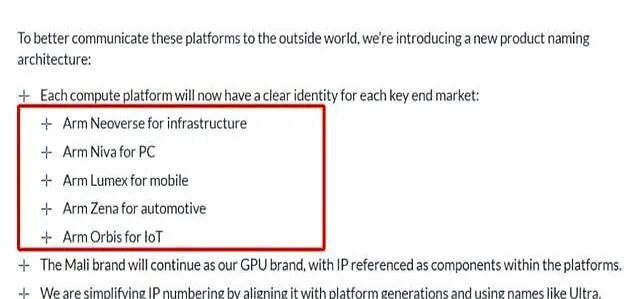
Arm has recently disclosed its product brand restructuring strategy, planning to provide self-developed chips to customers, while also mentioning its reliance on the Chinese market and the competitive risks posed by RISC-V.ARM has suddenly announced the abandonment of the Cortex brand, which it has used for twenty years. This once-arrogant British chip giant may indeed be starting to panic.
China contributes nearly 20% of ARM’s revenue, with companies like Huawei, Xiaomi, and OPPO being major clients. However, these Chinese enterprises have suddenly begun developing their own chips, ranging from IoT to AI chips, from laptops to servers. Chinese chips are carving out a bloody path using open-source architectures, fundamentally threateningARM’s lifeline!
ARM has launched five new brands at once: Neoverse, Lumex, Niva, Zena, Orbis… resembling a market vendor shouting out prices, eager to label every application scenario. Even more ridiculous is the performance grading: Ultra, Premium, Pro, Nano, Pico—this is nothing but the same old tricks of smartphone manufacturers with their “Youth Edition” and “Premium Edition”. A company that relies on technology has fallen to the point of needing to save itself through packaging concepts, which is quite an embarrassing sight.
ARM’s anxiety precisely confirms a harsh reality: the walls of Western technological hegemony are collapsing. In the past, it made money effortlessly through its “architecture licensing” model, with Chinese companies paying a “toll fee” for every chip sold. Now RISC-V has arrived, being open-source, free, and customizable, just like Linux once overthrew Windows’ dominance. The rules of this architectural revolution will be completely rewritten.
Ultimately, ARM’s branding tricks are merely a desperate struggle. What it truly fears is not whether a few new brands will succeed, but that Chinese companies have finally awakened: core technologies cannot be bought, begged for, or negotiated. When Alibaba’s T-head’s RISC-V chips enter data centers, and Loongson’s LoongArch architecture begins ecosystem development, the outcome of this contest is already determined.
The high walls built over twenty years cannot withstand the torrent of the open-source era. The more ARM engages in grand branding marketing, the more it exposes the fragility of its technological moat.